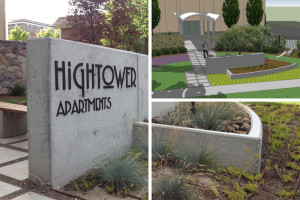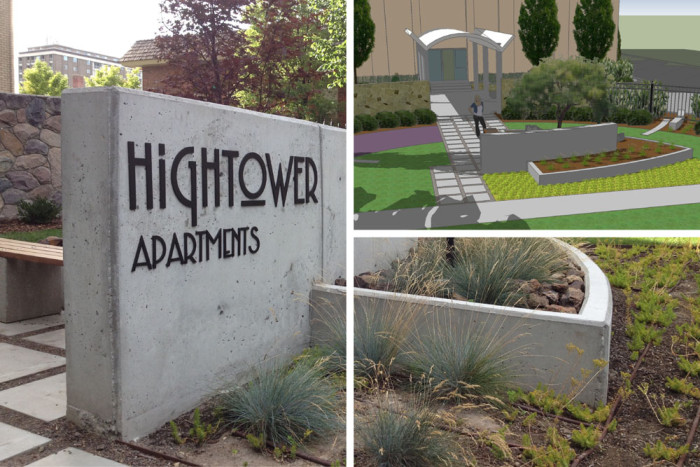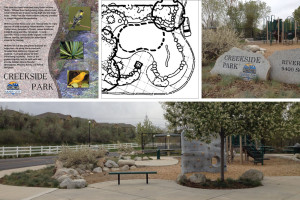Sustainable design strategies in landscape architecture
 In an era where environmental consciousness is paramount, the field of landscape architecture plays a pivotal role in shaping spaces that not only enhance human experience but also prioritize sustainability. The marriage of nature and development is not just an idea but a practical necessity for the well-being of our planet. This blog delves into sustainable design strategies employed by landscape architects, highlighting their crucial role in creating spaces that harmonize with the environment.
In an era where environmental consciousness is paramount, the field of landscape architecture plays a pivotal role in shaping spaces that not only enhance human experience but also prioritize sustainability. The marriage of nature and development is not just an idea but a practical necessity for the well-being of our planet. This blog delves into sustainable design strategies employed by landscape architects, highlighting their crucial role in creating spaces that harmonize with the environment.
1. Native plant palette: Cultivating biodiversity
One of the foundational principles of sustainable landscape design is the incorporation of native plant species. Native plants are adapted to the local climate, requiring less water and maintenance. Their use promotes biodiversity, supporting local ecosystems and contributing to the overall health of the environment. Landscape architects carefully select plants that thrive naturally in the region, fostering resilience and reducing the need for extensive irrigation.
2. Water efficiency: From conservation to innovation
Water scarcity is a global concern, making efficient water management a core component of sustainable landscape architecture. Designers implement strategies such as rainwater harvesting, permeable paving, and drought-tolerant plantings to reduce water consumption. Smart irrigation systems equipped with sensors ensure that water is used judiciously, responding to real-time weather conditions. These practices not only conserve water but also contribute to the overall sustainability of the landscape.
3. Regenerative design: Healing the urban fabric
Regenerative design goes beyond sustainability by actively contributing to the restoration and improvement of ecosystems. Landscape architects, in collaboration with civil engineers, strive to create spaces that regenerate soil health, enhance biodiversity, and mitigate environmental degradation. By integrating regenerative principles, landscape architecture becomes a catalyst for positive change, breathing new life into urban and suburban environments.
4. Green infrastructure: Nature as a functional element
Green infrastructure transforms landscapes into multifunctional spaces that mimic natural processes. Landscape architects enhance environmental performance while providing functional benefits by incorporating elements such as green roofs, bioswales, and urban forests. Green roofs, for example, improve energy efficiency, reduce stormwater runoff, and create habitats for local fauna. These integrated solutions showcase how nature can be seamlessly woven into the built environment.
5. Site analysis and planning: Informed decision-making
Sustainable landscape design begins with a thorough site analysis. Landscape architects carefully assess the site’s topography, microclimate, and existing ecosystems. This data-driven approach informs decision-making, allowing designers to work with the natural features of the land rather than against them. By understanding the unique characteristics of each site, landscape architects create designs that are not only aesthetically pleasing but also inherently sustainable.
6. Material selection: From recyclability to longevity
Conscious material selection is a key aspect of sustainable landscape architecture. Designers prioritize materials with low environmental impact, considering factors such as recyclability, durability, and embodied energy. Using recycled and locally sourced materials reduces the carbon footprint of projects. Additionally, the incorporation of long-lasting materials minimizes the need for frequent replacements, contributing to the overall longevity and sustainability of the landscape.
7. Community engagement: Fostering stewardship
Successful sustainable design goes hand in hand with community engagement. Landscape architects actively involve the community in the design process, considering local needs and aspirations. Engaging the community fosters a sense of ownership and stewardship, ensuring that the designed landscapes are respected and well-maintained. Sustainable landscapes thrive when they become an integral part of the community’s identity and daily life.
8. Education and advocacy: Spreading the green message
Landscape architects serve as advocates for sustainable practices, using their expertise to educate clients, communities, and fellow professionals. By raising awareness about the benefits of sustainable design, they contribute to a broader cultural shift towards environmentally conscious living. Education becomes a powerful tool in creating a collective commitment to sustainable practices and fostering a deeper connection between people and the landscapes they inhabit.
9. Energy-efficient lighting: Illuminating the green path
In sustainable landscape architecture, lighting is not just about visibility; it’s an opportunity to minimize energy consumption. Landscape architects strategically deploy energy-efficient lighting solutions, such as LED fixtures powered by renewable energy sources. By illuminating pathways, green spaces, and focal points with eco-friendly lighting, designers contribute to a reduced carbon footprint and create a safer, visually appealing environment.
10. Urban heat island mitigation: Cooling concrete jungles
Urban Heat Islands (UHIs) pose significant challenges to the environmental well-being of urban areas. Sustainable landscape architects tackle this issue head-on by integrating strategies to mitigate heat buildup. Through the strategic placement of shade-providing trees, green roofs, and reflective materials, designers create urban oases that counteract heat island effects. These thoughtful interventions enhance the overall livability of urban spaces and promote a healthier urban environment.
Transforming visions into sustainable realities with McNeil Engineering
At McNeil Engineering, we understand the integral role that sustainable design plays in shaping the future of our communities. Our interdisciplinary team, including expert landscape architects, is dedicated to transforming visions into sustainable realities. Collaborate with us to bring environmentally conscious and resilient landscapes to life. Visit McNeil Engineering to explore our comprehensive range of services and embark on a journey towards sustainable design excellence. Together, let’s build a greener, more sustainable tomorrow.



 In the realm of civil engineering, the pursuit of resilience is non-negotiable. Ensuring the longevity and safety of structures is not just a matter of engineering acumen; it’s a commitment to the well-being of communities and the sustainable development of our environments. This blog delves into the critical importance of designing for resilience in civil engineering projects, exploring the incorporation of structural safety measures that stand as guardians against the forces of time and nature.
In the realm of civil engineering, the pursuit of resilience is non-negotiable. Ensuring the longevity and safety of structures is not just a matter of engineering acumen; it’s a commitment to the well-being of communities and the sustainable development of our environments. This blog delves into the critical importance of designing for resilience in civil engineering projects, exploring the incorporation of structural safety measures that stand as guardians against the forces of time and nature.
 In the pursuit of creating sustainable landscapes, the choice of materials is a pivotal factor that can significantly impact the environmental footprint of a project. Opting for eco-friendly materials not only contributes to the conservation of natural resources but also promotes a healthier and more resilient ecosystem. In this comprehensive guide, we delve into the world of sustainable landscaping, offering insights on selecting eco-friendly materials, with a focus on recycled pavers and low-impact hardscape materials.
In the pursuit of creating sustainable landscapes, the choice of materials is a pivotal factor that can significantly impact the environmental footprint of a project. Opting for eco-friendly materials not only contributes to the conservation of natural resources but also promotes a healthier and more resilient ecosystem. In this comprehensive guide, we delve into the world of sustainable landscaping, offering insights on selecting eco-friendly materials, with a focus on recycled pavers and low-impact hardscape materials.
 In the realm of civil engineering and infrastructure development, the art of paving consulting emerges as a crucial facet in ensuring safe and durable surfaces. Whether it’s roads, parking lots, or walkways, the intricate process of designing and implementing paving solutions requires a blend of engineering expertise and aesthetic considerations. In the blog post below, we delve into the nuanced world of paving consulting, unraveling the principles that contribute to the creation of surfaces that stand the test of time.
In the realm of civil engineering and infrastructure development, the art of paving consulting emerges as a crucial facet in ensuring safe and durable surfaces. Whether it’s roads, parking lots, or walkways, the intricate process of designing and implementing paving solutions requires a blend of engineering expertise and aesthetic considerations. In the blog post below, we delve into the nuanced world of paving consulting, unraveling the principles that contribute to the creation of surfaces that stand the test of time.
 In the intricate dance of real estate transactions, few elements are as pivotal as accurate land surveying. As buyers and sellers engage in the complex process of property exchange, the role of land surveyors becomes paramount in ensuring clarity, transparency, and a seamless transition of ownership. Our blog explores the indispensable role of land surveying in real estate transactions, shedding light on why it is a critical component of the journey from property listing to keys changing hands.
In the intricate dance of real estate transactions, few elements are as pivotal as accurate land surveying. As buyers and sellers engage in the complex process of property exchange, the role of land surveyors becomes paramount in ensuring clarity, transparency, and a seamless transition of ownership. Our blog explores the indispensable role of land surveying in real estate transactions, shedding light on why it is a critical component of the journey from property listing to keys changing hands.
 Paving, once a utilitarian necessity, has evolved into an art form that melds functionality with aesthetics. Roads, driveways, parking lots, and walkways are not just surfaces to travel upon; they are integral components of our infrastructure. As we move towards a more sustainable and technologically advanced future, the world of paving design and construction is undergoing a profound transformation. In this blog, we’ll explore the latest technologies that are paving the way for a more efficient, eco-friendly, and visually appealing built environment. From permeable pavement systems to digital modeling tools, these innovations are shaping the future of paving.
Paving, once a utilitarian necessity, has evolved into an art form that melds functionality with aesthetics. Roads, driveways, parking lots, and walkways are not just surfaces to travel upon; they are integral components of our infrastructure. As we move towards a more sustainable and technologically advanced future, the world of paving design and construction is undergoing a profound transformation. In this blog, we’ll explore the latest technologies that are paving the way for a more efficient, eco-friendly, and visually appealing built environment. From permeable pavement systems to digital modeling tools, these innovations are shaping the future of paving.
 A roofing consultation serves as a crucial cornerstone in the journey toward a secure and resilient roof. Whether it’s a commercial property or a residential abode, the significance of a thorough roofing assessment, detailed recommendations, and efficient project management cannot be overlooked. In this comprehensive guide, we’ll delve into the intricacies of what clients can expect during a roofing consultation, from the initial assessment stages to the final project execution. Join us as we unravel the key elements of a successful roofing consultation that ensures a durable and reliable roofing solution for your property.
A roofing consultation serves as a crucial cornerstone in the journey toward a secure and resilient roof. Whether it’s a commercial property or a residential abode, the significance of a thorough roofing assessment, detailed recommendations, and efficient project management cannot be overlooked. In this comprehensive guide, we’ll delve into the intricacies of what clients can expect during a roofing consultation, from the initial assessment stages to the final project execution. Join us as we unravel the key elements of a successful roofing consultation that ensures a durable and reliable roofing solution for your property.
 In the dynamic world of structural engineering, precision, efficiency, and collaboration are paramount. As technology evolves, the industry is witnessing a transformative shift toward innovative solutions, and Building Information Modeling (BIM) is at the forefront. This revolutionary approach is not just about creating digital representations of structures but extends to clash detection and conflict resolution, fundamentally changing the way we approach structural design. In this comprehensive exploration, we’ll delve into the significance of using BIM for clash detection and conflict resolution, and how it elevates the standards of structural engineering.
In the dynamic world of structural engineering, precision, efficiency, and collaboration are paramount. As technology evolves, the industry is witnessing a transformative shift toward innovative solutions, and Building Information Modeling (BIM) is at the forefront. This revolutionary approach is not just about creating digital representations of structures but extends to clash detection and conflict resolution, fundamentally changing the way we approach structural design. In this comprehensive exploration, we’ll delve into the significance of using BIM for clash detection and conflict resolution, and how it elevates the standards of structural engineering.
 In the ever-evolving skyline of modern cities, tall buildings stand as iconic symbols of architectural prowess and engineering innovation. The realm of tall building design has witnessed a paradigm shift, embracing cutting-edge technologies and groundbreaking approaches that not only redefine aesthetics but also prioritize sustainability, safety, and functionality. Join us on a captivating exploration as we unravel the innovative approaches shaping the future of tall building design.
In the ever-evolving skyline of modern cities, tall buildings stand as iconic symbols of architectural prowess and engineering innovation. The realm of tall building design has witnessed a paradigm shift, embracing cutting-edge technologies and groundbreaking approaches that not only redefine aesthetics but also prioritize sustainability, safety, and functionality. Join us on a captivating exploration as we unravel the innovative approaches shaping the future of tall building design.
 In the realm of modern landscape design, sustainability has become more than just a buzzword; it’s a guiding principle. As the world increasingly prioritizes eco-conscious practices, the importance of selecting the right materials for sustainable landscaping projects cannot be overstated. From mindful resource usage to eco-friendly design elements, every choice plays a pivotal role in creating a greener, more sustainable environment. In this comprehensive guide, we will explore the key considerations and best practices for selecting the most appropriate and environmentally friendly materials for your landscaping projects. By the end, you’ll be equipped with the knowledge to create stunning outdoor spaces that not only enhance the aesthetic appeal of your property but also contribute to a more sustainable future.
In the realm of modern landscape design, sustainability has become more than just a buzzword; it’s a guiding principle. As the world increasingly prioritizes eco-conscious practices, the importance of selecting the right materials for sustainable landscaping projects cannot be overstated. From mindful resource usage to eco-friendly design elements, every choice plays a pivotal role in creating a greener, more sustainable environment. In this comprehensive guide, we will explore the key considerations and best practices for selecting the most appropriate and environmentally friendly materials for your landscaping projects. By the end, you’ll be equipped with the knowledge to create stunning outdoor spaces that not only enhance the aesthetic appeal of your property but also contribute to a more sustainable future.